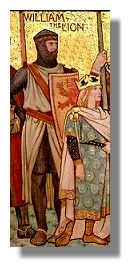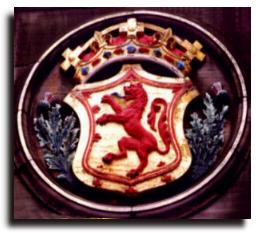 William "The Lion" was a grandson of King David I and came to the throne after the death of his elder brother, Malcolm IV in 1165. The nickname "The Lion" was accorded to him after his death and may have been due either to his valour and strength in battle (though he was not always successful) or, more likely, to the heraldic symbol which he adopted - the red lion rampant on a yellow background - which has remained a royal symbol to this day.
William "The Lion" was a grandson of King David I and came to the throne after the death of his elder brother, Malcolm IV in 1165. The nickname "The Lion" was accorded to him after his death and may have been due either to his valour and strength in battle (though he was not always successful) or, more likely, to the heraldic symbol which he adopted - the red lion rampant on a yellow background - which has remained a royal symbol to this day.
William was crowned at Scone on December 24, 1165 at the age of 22 and was to reign for nearly 50 years - a prodigious length of time by any standards, but unheard of in those violent days.
William was red-haired and energetic. Early in his reign he attempted to recover land in Northumberland which had been given to King David in 1149 by King Stephen of England but which had been ceded by his brother Malcolm. The stories of his butchery of the local population were chronicled in detail by later (English) historians. However, he was ultimately unsuccessful as he was surprised by an attack by the English army while besieging Alnwick castle. In the mist, he mistook a party of English knights for his own. He is said to have fought fearlessly but his horse was speared and he was captured. He spent five months as a prisoner of Henry II while the English army plundered the south of Scotland as far as Edinburgh.
 William was only released under the Treaty of Falaise. Under this, William was forced to swear allegiance to King Henry II of England and English garrisons remained in the castles which had been captured. This lasted until after Henry's death in 1189. At that stage he was able to negotiate out of the oath by providing money to King Richard (the Lionheart) who needed finance to go on a crusade to the Holy Land.
William was only released under the Treaty of Falaise. Under this, William was forced to swear allegiance to King Henry II of England and English garrisons remained in the castles which had been captured. This lasted until after Henry's death in 1189. At that stage he was able to negotiate out of the oath by providing money to King Richard (the Lionheart) who needed finance to go on a crusade to the Holy Land.
In 1178 William founded the Abbey of Arbroath which was dedicated to Thomas à Becket who had been murdered by Henry II in 1170. The Abbey was later to be place where the famous "Declaration of Arbroath" was signed in 1320 by the Scottish nobles in the time of Robert the Bruce.
William failed to assert his authority over the rebellious south-west of Scotland. This was not helped by the fact that he had to first ask permission of his "liege-lord" Henry to be allowed to deal with the matter. William captured one of the ring-leaders but had to send him to Henry to be dealt with. Henry demand an oath of loyalty - and promptly returned the outlaw to Galloway where he immediately attacked William's garrison.
William is known to have been planning another invasion of England to retake Northumberland early in the 13th century after King John came to the throne of England and there were a number of skirmishes along the border. But he eventually negotiated a treaty instead - he is said to have had a "divine warning" of the consequences of invasion.
In 1186 William married Ermengarde de Beaumont who at last bore him a son in 1198 (later King Alexander II) when William was aged 53. He also had three daughters (all of whom married English nobles as part of the peacemaking process with King John of England).



